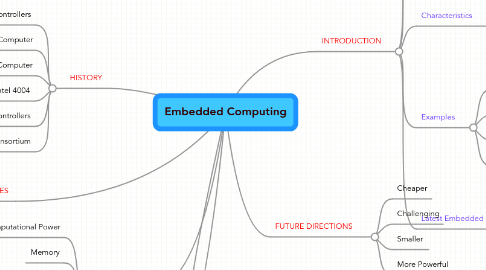Embedded Computing
저자: monica duenas


1. HISTORY
1.1. 1940: Programmable Controllers
1.2. 1961: Autonetics D-17 Guidance Computer
1.3. 1960s: Apollo Guidance Computer
1.4. End of 1960s: Intel 4004
1.5. 1980s: Microcontrollers
1.6. 1992: PC/104 Consortium
2. CHALLENGES
2.1. Complexity
2.2. Testing
2.3. Predicability
2.4. Specification
2.5. Domain Knowledge
2.6. Fault Tolerance
3. ATTRIBUTES
3.1. Computational Power
3.2. Memory
3.3. Real-Time
3.4. Communication
3.5. Dynamic Decisions
4. APPLICATIONS
4.1. Music System
4.2. Card Reader
4.3. Washing Machine
4.4. Digital Watch
4.5. Video Game Player
5. PRACTICAL AREAS OF APPLICATION
5.1. Aerospace
5.2. Automotive
5.3. Children's Toys
5.4. Communications
5.5. Computer Peripherals
5.6. Home
5.7. Industrial
5.8. Instrumentation
5.9. Medical
5.10. Office Automation
5.11. Personal
6. INTRODUCTION
6.1. What is an Embedded System?
6.1.1. Defintion 1
6.1.2. Definition 2
6.2. Description
6.2.1. Desc. 1
6.2.2. Desc. 2
6.2.3. Desc. 3
6.2.4. Desc. 4
6.3. Characteristics
6.3.1. Char. 1
6.3.2. Char. 2
6.3.3. Char. 3
6.3.4. Char. 4
6.4. Examples
6.4.1. Personal Digital Assistants
6.4.2. MP3 Player
6.4.3. Video Game Consoles
6.4.4. Network Routers
6.5. Latest Embedded Computer Devices
6.5.1. iRobot ConnectR
6.5.2. HDMS-S1D Digital Photo Album
6.5.3. BM-ET200 Iris Reader
6.5.4. Surface
